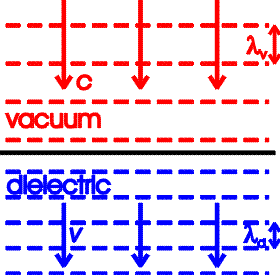Light in a dielectric medium When light enters a dielectric medium (e.g. plastic or glass) the electric fields are damped by the dielectric material, which in turn affects the speed of light in the medium. We refer to the index of refraction n which gives the degree to which light is slowed in the medium. The index of refraction is always greater than unity, as nothing moves faster than c, unless one is in a vacuum.
The figure on the right illustrates this as the wave fronts are shown by the dashed lines. If light were to enter one dielectric from another one, n would be replace by the ratio of the indices of refraction. |









 When light
enters a dielectric as shown on the right, the speed of
the signal slows down while the frequency stays constant.
This is analagous to traffic entering a slower stretch of
road. In that instance, the number of cars entering the
stretch per second must be the same as the number of cars
per second that pass any point of the stretch which means
that the frequency is the same. But, the spacing of the
cars is reduced. Similarly, the wavelength of light in
the dielectric ld is reduced
from what it was in the vacuum lv.
When light
enters a dielectric as shown on the right, the speed of
the signal slows down while the frequency stays constant.
This is analagous to traffic entering a slower stretch of
road. In that instance, the number of cars entering the
stretch per second must be the same as the number of cars
per second that pass any point of the stretch which means
that the frequency is the same. But, the spacing of the
cars is reduced. Similarly, the wavelength of light in
the dielectric ld is reduced
from what it was in the vacuum lv.